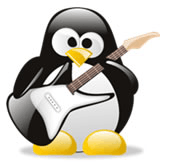TuxGuitar
 | |
 | |
| Original author(s) | Julian Gabriel Casadesus and others[1] |
|---|---|
| Stable release |
1.3.2
/ March 16, 2016 |
| Repository |
sourceforge |
| Development status | Active |
| Written in | Java, Standard Widget Toolkit (SWT) |
| Operating system | Linux, Microsoft Windows, Mac OS X, FreeBSD |
| Available in | English |
| Type | Tablature editor, Scorewriter |
| License | LGPLv2.1 |
| Website |
tuxguitar |
TuxGuitar is a free, open source tablature editor, which includes features such as tablature editing, score editing, and import and export of Guitar Pro gp3, gp4, and gp5 files.[2] In addition, TuxGuitar's tablature and staff interfaces function as basic MIDI editors.
TuxGuitar's mascot and namesake is Tux, the penguin mascot of many games and programs originally designed for Linux.
The program is written in the Java programming language[3] and is released under version 2.1 of the GNU Lesser General Public License.
TuxGuitar 1.2 was released in 2009.[4] Its source code was steadily updated through 2015 culminating in a release of version 1.3.0 in January 2016.[5]
Skins
TuxGuitar offers a set of three default skins that its users can choose from. These are:
| Image | Name | Author | First appeared in | Description |
|---|---|---|---|---|
| |
Lavender | Sascha | v0.1 | Simple, elegant theme with lavender color. |
| Blue serious | Licnep | v0.1 | A more serious theme, where blue dominates. | |
| |
Ersplus | Ersplus | v0.9 | Default tuxguitar theme. |
TuxGuitar also supports custom skins. The default skin for version 1.0 is Lavender.
Supported effects
| Note effects | |
|---|---|
| Dead notes | Supported. |
| Accentuated notes | Only heavy or regular. |
| Harmonics | Only natural, artificial, tapped, pinched, or semi harmonic. |
| Dynamics | Not displayed in the body of the score. |
| Grace notes | Limited to a duration ranging from 1/64 to 1/16 of a whole note. |
| Tremolo picking | Limited to a duration of at most 1/8 and at least 1/32 of a whole note. |
| Slurs | Not supported. |
| Hammer-ons and pull-offs | Limited support (the program doesn't differentiate between the two). |
| Slides | Limited support. |
| Track effects | |
| Multiple Tracks | Supported, can be displayed by clicking View > Multitrack. |
| Multiple Voices | Supported but limited to two voices per track. |
| Repeats | Supported but limited to either open or closed barline repeats. |
| Alter. Endings | Supported but MIDI playback will only recognize the first two alternative endings, the second of which must be located above the measure that directly follows the closed repeat in order for it to be associated with the first alternative ending and the repeat in question. |
| Custom Number of and Tuning for a Track's strings | Supported but the number of strings that can be added is limited to no more than 7 and no less than 4 and they can be set to any pitch within the range of 16.352Hz and 15804.266Hz, inclusive. Does not currently allow for different-length courses, e.g. five-string banjo. |
| Track Names | Supported. |
| Lyrics | Supported. |
| Text | Supported. |
| Chords | Supported.[6] |
| Symbols | Supported but limited to time signatures, clefs, and key signatures. (Instructional performance text can be added instead of symbols via the Text editor but they will not be supported by the MIDI playback or be recognized by TuxGuitar as anything but text.) |
Supported file formats
| File format | Loading | Exporting |
|---|---|---|
| TuxGuitar (.tg) | Yes | Yes |
| Guitar Pro (.gtp) | Yes | No |
| Guitar Pro 3 (.gp3) | Yes | Yes |
| Guitar Pro 4 (.gp4) | Yes | Yes |
| Guitar Pro 5 (.gp5) | Yes | Yes |
| Guitar Pro 6 (.gpx) | Yes | No |
| Power Tab (.ptb) | Yes | No |
| TablEdit (.tef) | Yes | No |
| GNU LilyPond (.ly) | No | Yes |
| MIDI (.mid) | Yes | Yes |
| ASCII tab (.txt) | No | Yes |
Reception
As of May 2014, TuxGuitar had 4/5 stars in the CNET user ratings.[7] During the same time, TuxGuitar had 3.4/5 stars in the Softpedia user ratings.[8] As of August 2016 the program has 4.7/5 stars on SourceForge.[9] Reviewers at Software Informer gave version 1.0 of TuxGuitar 5/5 stars, praising the "very easy to use interface" and "very advanced functions" of the program.[10]
See also
References
- ↑ "TuxGuitar 1.2 Download". download.chip.eu. Retrieved 6 January 2016.
- ↑ Mantilla, Daniel. "TuxGuitar: Editorial review". Software Informer. Retrieved 12 May 2014.
- ↑ Smith, Tim. "TuxGuitar 1.2". Computeractive. Retrieved 20 August 2011.
- ↑ "TuxGuitar 1.2 has been released". SourceForge. 3 November 2009. Retrieved 6 January 2016.
- ↑ "TuxGuitar". SourceForge. Retrieved 6 January 2016.
- ↑ Westermann, Lucas (25 September 2010). "TuxGuitar Review" (PDF). Full Circle Magazine (41): 24. Retrieved 21 August 2011.
- ↑ "TuxGuitar: Average User Rating". CNET. Retrieved 12 May 2014.
- ↑ "TuxGuitar 1.2: User Rating". Softpedia. Retrieved 12 May 2014.
- ↑ "TuxGuitar: Reviews". SourceForge. Retrieved 14 August 2016.
- ↑ Mantilla, Daniel. "TuxGuitar: Editorial review". Software Informer. Retrieved 12 May 2014.